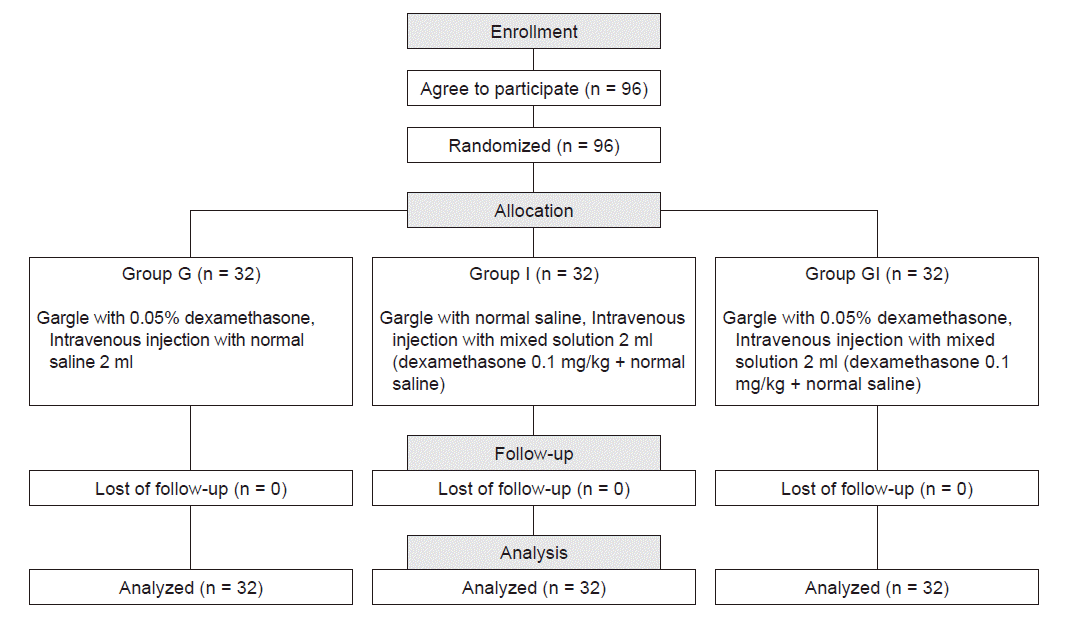1. Xu YJ, Wang SL, Ren Y, Zhu Y, Tan ZM. A smaller endotracheal tube combined with intravenous lidocaine decreases post-operative sore throat - a randomized controlled trial. Acta Anaesthesiol Scand. 2012; 56:1314–20.
2. Park SH, Han SH, Do SH, Kim JW, Rhee KY, Kim JH. Prophylactic dexamethasone decreases the incidence of sore throat and hoarseness after tracheal extubation with a double-lumen endobronchial tube. Anesth Analg. 2008; 107:1814–8.
3. Hung NK, Wu CT, Chan SM, Lu CH, Huang YS, Yeh CC, et al. Effect on postoperative sore throat of spraying the endotracheal tube cuff with benzydamine hydrochloride, 10% lidocaine, and 2% lidocaine. Anesth Analg. 2010; 111:882–6.
4. Al-Qahtani AS, Messahel FM. Quality improvement in anesthetic practice--incidence of sore throat after using small tracheal tube. Middle East J Anaesthesiol. 2005; 18:179–83.
5. Teymourian H, Mohajerani SA, Farahbod A. Magnesium and ketamine gargle and postoperative sore throat. Anesth Pain Med. 2015; 5:e22367.
6. Yang C, Jung SM, Bae YK, Park SJ. The effect of ketorolac and dexamethasone on the incidence of sore throat in women after thyroidectomy: a prospective double-blinded randomized trial. Korean J Anesthesiol. 2017; 70:64–71.
7. Lee JH, Kim SB, Lee W, Ki S, Kim MH, Cho K, et al. Effects of topical dexamethasone in postoperative sore throat. Korean J Anesthesiol. 2017; 70:58–63.
8. Moon YE. Postoperative nausea and vomiting. Korean J Anesthesiol. 2014; 67:164–70.
9. Haider HS, Al-Ali BT. The role of dexamethasone in reducing the severity of postoperative sore throat. Iraqi Acad Sci J. 2013; 12:454–9.
10. Zhao X, Cao X, Li Q. Dexamethasone for the prevention of postoperative sore throat: a systematic review and meta-analysis. J Clin Anesth. 2015; 27:45–50.
11. Lee SH, Lee YC, Lee JH, Choi SR, Lee SC, Lee JH, et al. The prophylactic effect of dexamethasone on postoperative sore throat in prone position surgery. Korean J Anesthesiol. 2016; 69:255–61.
12. Choung YH, Cho MJ, Kim CH, Lee J, Kang SO. Preliminary results of steroid gargle treatment and clinical characteristics of patients with burning mouth syndrome. Korean J Otolaryngol-Head Neck Surg. 2004; 47:569–74.
13. Park SY, Kim SH, Lee AR, Cho SH, Chae WS, Jin HC, et al. Prophylactic effect of dexamethasone in reducing postoperative sore throat. Korean J Anesthesiol. 2010; 58:15–9.
14. Brunner E, Domhof S, Langer F. Nonparametric analysis of longitudinal data in factorial experiments. New York, Wiley;2002.
15. De Oliveira GS Jr, Ahmad S, Fitzgerald PC, Marcus RJ, Altman CS, Panjwani AS, et al. Dose ranging study on the effect of preoperative dexamethasone on postoperative quality of recovery and opioid consumption after ambulatory gynaecological surgery. Br J Anaesth. 2011; 107:362–71.
16. Kim D, Jeon B, Son JS, Lee JR, Ko S, Lim H. The changes of endotracheal tube cuff pressure by the position changes from supine to prone and the flexion and extension of head. Korean J Anesthesiol. 2015; 68:27–31.
17. Mencke T, Echternach M, Kleinschmidt S, Lux P, Barth V, Plinkert PK, et al. Laryngeal morbidity and quality of tracheal intubation: a randomized controlled trial. Anesthesiology. 2003; 98:1049–56.
18. Subedi A, Tripathi M, Pokharel K, Khatiwada S. Effect of intravenous lidocaine, dexamethasone, and their combination on postoperative sore throat: a randomized controlled trial. Anesth Analg. 2019; 129:220–5.
19. Park SY, Kim SH, Lee SJ, Chae WS, Jin HC, Lee JS, et al. Application of triamcinolone acetonide paste to the endotracheal tube reduces postoperative sore throat: a randomized controlled trial. Can J Anaesth. 2011; 58:436–42.
20. Gupta P, Khanna J, Mitramustafi AK, Bhartia VK. Role of pre-operative dexamethasone as prophylaxis for postoperative nausea and vomiting in laparoscopic surgery. J Minim Access Surg. 2006; 2:12–5.
21. Ismail EA, Abo Elfadl GM, Bahloul M. Comparison of intraperitoneal versus intravenous dexamethasone on postoperative nausea and vomiting after gynecological laparoscopy: a randomized clinical trial. Korean J Anesthesiol. 2019; 72:47–52.
22. Yao XL, Cowan MJ, Gladwin MT, Lawrence MM, Angus CW, Shelhamer JH. Dexamethasone alters arachidonate release from human epithelial cells by induction of p11 protein synthesis and inhibition of phospholipase A2 activity. J Biol Chem. 1999; 274:17202–8.
23. Deming MV, Oech SR. Steroid and antihistaminic therapy for post intubation subglottic edema in infants and children. Anesthesiology. 1961; 22:933–6.
24. Seervi SN, Singariya G, Kamal M, Kumari K, Siddeshwara A, Ujwal S. Effect of addition of buprenorphine or dexamethasone to levobupivacaine on postoperative analgesia in ultrasound guided transversus abdominis plane block in patients undergoing unilateral inguinal hernia repair: a prospective randomized double blind controlled trial. Korean J Anesthesiol. 2019; 72:245–52.
25. Jeong SH, Ok SM, Huh JY, Ko MY, Ahn YW. A study for direct application of drug on oral mucosa. J Oral Med Pain. 2010; 35:229–35.
26. Park AR, La HO, Cho BS, Kim SJ, Lee BK, Rhie JY, et al. Comparison of budesonide and dexamethasone for local treatment of oral chronic graft-versus-host disease. Am J Health Syst Pharm. 2013; 70:1383–91.
27. Mayhood J, Cress K. Effectiveness of ketamine gargle in reducing postoperative sore throat in patients undergoing airway instrumentation: a systematic review. JBI Database System Rev Implement Rep. 2015; 13:244–78.
28. Safavi M, Honarmand A, Fariborzifar A, Attari M. Intravenous dexamethasone versus ketamine gargle versus intravenous dexamethasone combined with ketamine gargle for evaluation of post-operative sore throat and hoarseness: a randomized, placebo-controlled, double blind clinical trial. Adv Biomed Res. 2014; 3:212.
29. Cho CK, Kim JE, Yang HJ, Sung TY, Kwon HU, Kang PS. The effect of combining lidocaine with dexamethasone for attenuating postoperative sore throat, cough, and hoarseness. Anesth Pain Med. 2016; 11:42–8.
30. Kim TY. Small but serious risk of perioperative steroid use. Korean J Anesthesiol. 2017; 70:1–2.




 PDF
PDF Citation
Citation Print
Print




 XML Download
XML Download